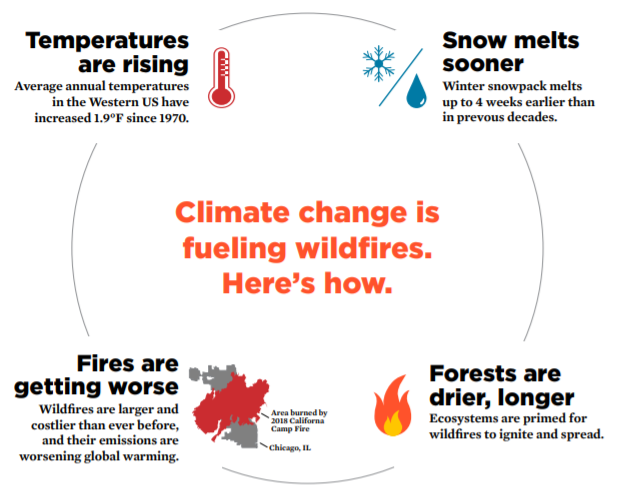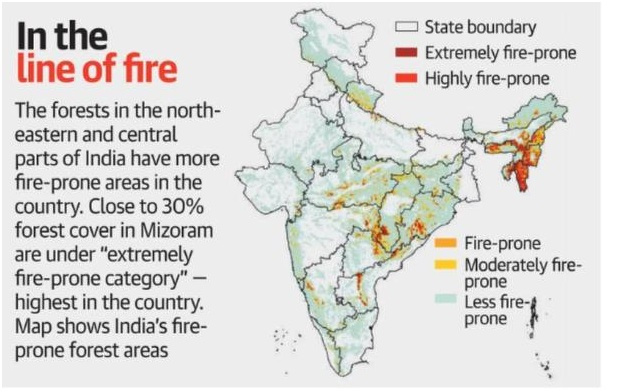Biodiversity & Environment
Climate Change and Forest Fire Link
- 28 Sep 2020
- 7 min read
Why in News
Scientists note that human-induced climate change promotes the conditions on which wildfires depend.
Key Points
- Wildfire: Also called forest, bush or vegetation fire, can be described as any uncontrolled and non-prescribed combustion or burning of plants in a natural setting such as a forest, grassland, brush land or tundra, which consumes the natural fuels and spreads based on environmental conditions (e.g., wind, topography).
- Wildfires can be incited by human actions, such as land clearing, extreme drought or in rare cases by lightning.
- There are three conditions that need to be present in order for a wildfire to burn: fuel, oxygen, and a heat source.
- Human-induced Climate Change: Increases in greenhouse gases resulting from human activities have led to a net effect of warming of the climate system leading to direct impacts including increased air and ocean temperatures, widespread melting of snow and ice and rising global average sea level. The increases in greenhouse gases can be attributed to fossil fuel use, land-use change, etc.
- Concerns:
- Forest fires have become an issue of global concern. In many countries, wildfires are burning larger areas, and fire seasons are growing longer due to global warming.
- Australia recently battled its largest bushfire on record, while parts of the Arctic, the Amazon and central Asia have also experienced unusually severe fires.
- Wildfires in Western USA (California) are another example.
- Globally, forest fires release billions of tons of CO2 into the atmosphere, while hundreds of thousands of people are believed to die due to illnesses caused by exposure to smoke from forest fires and other landscape fires.
- Factors:
- Fire Weather:
- Climate change increases the frequency and severity of fire weather around the world.
- Increased fire weather from climate change amplifies fire risk where fuels remain available.
- Fire weather is a combination of conditions that set the stage for the rapid spread of wildfires.
- High temperature
- Low Relative humidity
- Strong sustained winds (> 20 mph) carry oxygen and spread flames.
- Poor land and forest management also contributes to the wildfires, however, it does not alone account for the recent increases in the extent and severity of the wildfires globally.
- Factors Identified by the IPCC: The Fifth Assessment Report of the Intergovernmental Panel on Climate Change (IPCC), published in 2013, identified a few factors that could influence the way wildfires play out. These include:
- Global increase in average temperatures.
- Global increases in the frequency, intensity and extent of heatwaves (breaching of historically extreme temperature thresholds).
- Regional increases in the frequency, duration and intensity of droughts.
- Fire Weather:
Indian Scenario
- Forest Fire & Monitoring:
- A joint study report of the Ministry of Environment and Forests (MoEF&CC) and World Bank titled “Strengthening Forest Fire Management in India” released in June 2018 revealed that in the year 2000, 20 districts, representing 3% of India’s land area and 16% of forest cover accounted for 44% of all fire detections.
- The upgraded version of the Forest Fire Alert System (FAST 3.0) was released in January, 2019 with a separate activity of monitoring large forest fires.
- Forest Cover of States & UTs under different fire prone classes:
- Extremely Fire Prone: Mizoram > Tripura
- Very Highly Fire Prone: Mizoram > Manipur
- Highly Fire Prone: Nagaland > Manipur
- Moderately Fire Prone: Punjab > Nagaland
- It is seen that most of the fire prone forest areas are found in the north-eastern region and the central part of the country.
- India’s Initiative to Tackle Forest Fire:
- National Action Plan on Forest Fires, 2018
- MoEF&CC, has come up with the National Action Plan on Forest Fires, 2018 to revamp forest fire management in the country.
- Objectives: Informing, Enabling and Empowering forest fringe communities and Incentivizing them to work in tandem with the State Forest Departments (SFDs).
- The plan proposes nine strategies to address the issue, including establishment of a “Centre of Excellence on Forest Fire Management”at Forest Survey of India (FSI).
- Forest Fire Prevention and Management Scheme:
- The Forest Fire Prevention and Management Scheme (FPM) is the only centrally funded program specifically dedicated to assist the states in dealing with forest fires.
- The FPM replaced the Intensification of Forest Management Scheme (IFMS) in 2017.
- Funds allocated under the FPM are according to a center-state cost-sharing formula, with a 90:10 ratio of central to state funding in the Northeast and Western Himalayan regions and a 60:40 ratio for all other states.
- It also provides the states the flexibility to direct a portion of the National Afforestation Programme (NAP) and Mission for Green India (GIM) funding toward forest fire work.
- National Action Plan on Forest Fires, 2018
Way Forward
- Climate change is the reality, so are the increased severe forest fires. Management of forest fire needs to be tackled at various levels.
- First, at local or regional level by minimising the accidental chances of man-made fires.
- At national level it requires a specific approach to manage resources like Land and Forest to reduce the chance of such fires. Also, the need to handle climate change must be a part of policy making and implementation.
- At global level a sincere effort to reduce the impact of climate change along with reduction in factors causing climate change should be a united priority of all nations. Only then the link between climate change and forest fires can be weakened.






